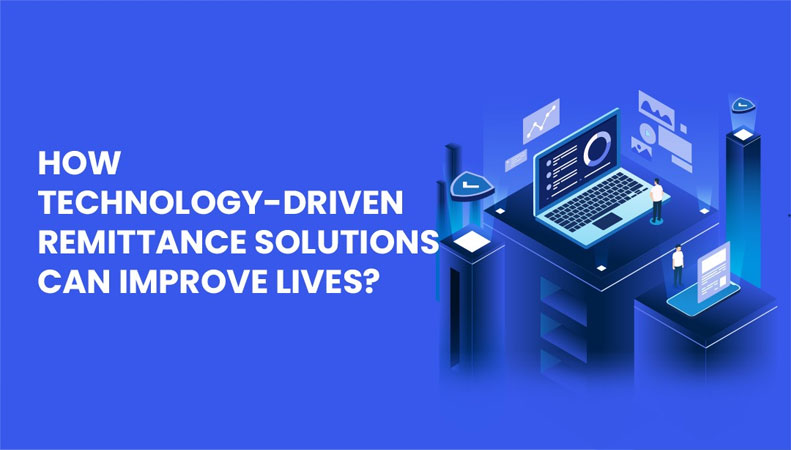
HOW TECHNOLOGY-DRIVEN REMITTANCE SOLUTIONS CAN IMPROVE LIVES
30th April 2021
Many families' livelihoods have benefited from the foreign remittance. Foreign remittances were projected to be $689 billion in 2018, up from $633 billion the previous year, according to the World Bank. India has maintained its status as the world's leading recipient of remittances. Without a question, the remittance industry is developing at an exponential pace. People are finding it easier to travel to other countries in search of better job opportunities due to increased globalisation, seamless visa procedures, and improved communication between countries. Technology is also a factor in the growth in remittances. The remittance industry has undergone a major transformation as a result of technological advancements.
A money transfer to a friend or family member in another country is known as a remittance. Millions of people around the world rely on this capital, which is frequently used for necessities such as food, housing, education, and healthcare. In reality, since 2000, remittances have been the single largest source of foreign exchange in developing countries, far exceeding international aid. Traditional remittances, on the other hand, mostly entail standing in line for many hours just to get money wired to pay bills, and they almost always come with a slew of fees.
More people in the world than ever before have access to financial accounts and resources. New products and services are being created as a result of this access to make it easier to use these accounts. Customers' ability to balance income and expenditures, create and retain reserves, and mitigate and recover from financial shocks using a variety of financial resources is referred to as healthy financial inclusion. The most valuable financial services are those that provide convenience to consumers and promote resilience by enhancing the user's ability to weather shocks and achieve financial objectives, thus effectively promoting the user's financial wellbeing.
Time-saving
Sending and receiving remittances can also be made easier with the use of technology. According to a Boston Consulting Group survey of five emerging markets, mobile financial services save 1% of income due to decreased travel and wait times.
Increased remittances have been linked to increased structured deposits and credits, according to research. Government deposit insurance schemes, which help to build confidence and use, are another advantage of banking for remitters and receivers. Remitters who use account-based transfers send 30% more than those who use more informal channels; these additional funds could help emerging market receivers adhere to the controlled financial system.
Convenience
The new technology also illustrates flexibility and peace of mind when making safe money transfers, anywhere, wherever, by demonstrating that users get SMS reminders when the money arrives - or a refund if money does not arrive in the unlikely case that money does not arrive. Money digitization is another important advancement. The way people shop, how retailers sell, and how people communicate with financial institutions are all experiencing major changes. Money's very essence is transforming. People all over the world will benefit from digital remittances because they allow them to do what they want with their money more safely, effectively, and affordably. This is the reason that e-wallets in Malaysia have taken off recently, with the country depending on cashless transactions to keep its money going.
When it comes to technology, the internet plays a critical role in remittance. Today, the internet has enabled people to keep in touch with their families while also providing opportunities to learn about a variety of emerging technology. For many families around the world, the remittance sector is a significant external source of financing. The conventional costs of handling and moving money across borders safely and productively have been relatively high. Increased access to financial services such as basic bank accounts and increased internet use among remittance recipients provide growth opportunities for the sector. The rise in digitization and automation reduced remittance cost and transfer time, and increased adoption of banking and financial services are driving the growth of the digital remittance market with the aid of the internet. In the global Digital Remittance Systems market, convergence is the secret to technological advancement. In the Digital Remittance Systems industry, companies that have the most up-to-date advanced technologies at a reasonable price are expected to do well.
Basic money transfers are just the beginning, and some businesses are reinventing the model by introducing cross-border bill payment and mobile reloading. In short, innovative technologies and developments for remittance services are enabled by an effective payment mechanism, a proper regulatory structure, and encouraging and competitive market conditions. More citizens getting access to transaction accounts will also reduce the use of cash in remittance transactions. Although the landscape will not full evolve overnight, recent progress could result in substantial improvements over the next decade.
Digitization of Money
People all over the world will benefit from digital remittances because they allow them to do what they want with their money more safely, effectively, and affordably. Basic Money Transfers are only the beginning, and some businesses are reinventing the model by integrating cross-border bill payment and mobile reloading. They're making inroads into areas like Sub-Saharan Africa and South Asia, and they're helping to change people's lives all over the world. Cross-border money transfers are a critical next step in the effort to fully democratize financial services for more people all over the world.
EVOLET is a digital wallet app for migrant workers.
Learn more at https://evolet.io/
